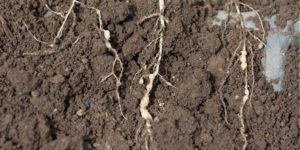The coffee berry borer (Hypothenemus hampei) is the most economically important coffee pest throughout all coffee-producing countries in the world.
These borers are the only known pests that feed exclusively on and live within coffee berries and are known to attack 100% of berries in a heavy infestation.
Crop losses can be very severe and coffee quality from damaged berries is greatly reduced.
Life Cycle
The life stages are egg, larva, pupa, and adult.
The female bores a hole in the coffee berry and makes galleries in the seed where she lays the eggs. Most of the life cycle occurs inside the berry and varies according to the temperature. This may last between 24 and 45 days. The new insects mate inside the seed.
The female lays 2-3 eggs per day for a period of 20 days.
Between harvest seasons, females remain inactive in old berries on the tree or ground waiting for the first rains, which stimulate them to emerge and search for new berries in which to begin the next cycle. Coffee berry borers develop faster on the ground due to less extreme temperatures.
Males do not fly and remain inside the berry
The lifespan for females is 35–190 days and for males 40 days.
Identification
Egg– they are elliptical or ovoid in shape, milky-white and shiny when first laid, about 0.7 mm long and 0.3mm wide.
Larvae – these are white, legless, with fine but sparse hairs, brown hypognathous head, 3-segmented thorax, 9-segmented abdomen and about 2.5mm long. They have well-developed mouth parts. There are two larval instars for the female and one for the male.
Pupae – they are white initially, but yellow after few days of development. Their mandibles, eyes, antennae, elytra and membranous wings are differentiated and easily visible. Females are 1.7 mm long and males are 1.2 mm.
Adults – males are wingless, stunted and deformed. Females are entirely black. The frontal margin of the pronotum has four teeth, setae erect and at least eight times as long as they are wide. The median frontal suture of the head is long and well defined.
Feeding & Damage
The coffee berry borer females attack immature and mature coffee berries from about eight weeks after flowering up to harvest season.
They bore holes into the coffee berries and construct galleries in the seeds where the eggs are deposited, followed by larval feeding on the coffee seeds.
Infestation causes premature fall of young berries, increased vulnerability of infested ripe berries to fungus or bacterial infection, and reduction in both yield and quality of coffee.
The coffee berry borer can cause high yield losses if not timely controlled.
Damage is usually greater if harvest is delayed.
Infestation can also be confirmed by cutting open the berry. If the endosperm is still watery, the female will be found in the mesoderm between the two seeds, waiting for the internal tissues to become more solid. If the endosperm is more developed, the borer will be found there amongst the excavations and irregular galleries that it has made.
Management & Control
Chemical control
This involves the use of insecticides. The insecticides however work effectively when applied before the female beetle penetrates the berry because the life cycle of the borers take place inside the berries. Therefore early/timely chemical spray and a regular spray regime is highly recommended.
The following are the recommended insecticides against coffee berry borers;
- LEXUS 247SC 8ml/20l
- PROFILE 440EC 30ml/20l
- RANGER 480EC 30ml/20l
- KINGCODE ELITE 50EC 10ml/20l
- SINOPHATE 750SP 20g/20l
- PRESENTO 200SP 5g/20l
While spraying the insecticides, it is advisable to mix it with INTEGRA 3ml/20l, which improves the efficacy of the chemical.
Several insecticides should be alternated in a crop’s season in order to prevent the pest from gaining resistance over either of the chemicals.
Non-chemical methods
They include the following;
- Practising rotations and intercropping to reduce pest population
- Maintenance of field sanitation
- Proper weed control
- Destroying the attacked berries by burying them deep in soil or by burning.
- Setting baited traps in the pruned fields
- Use of natural enemies of the coffee berry bore to reduce the population.






